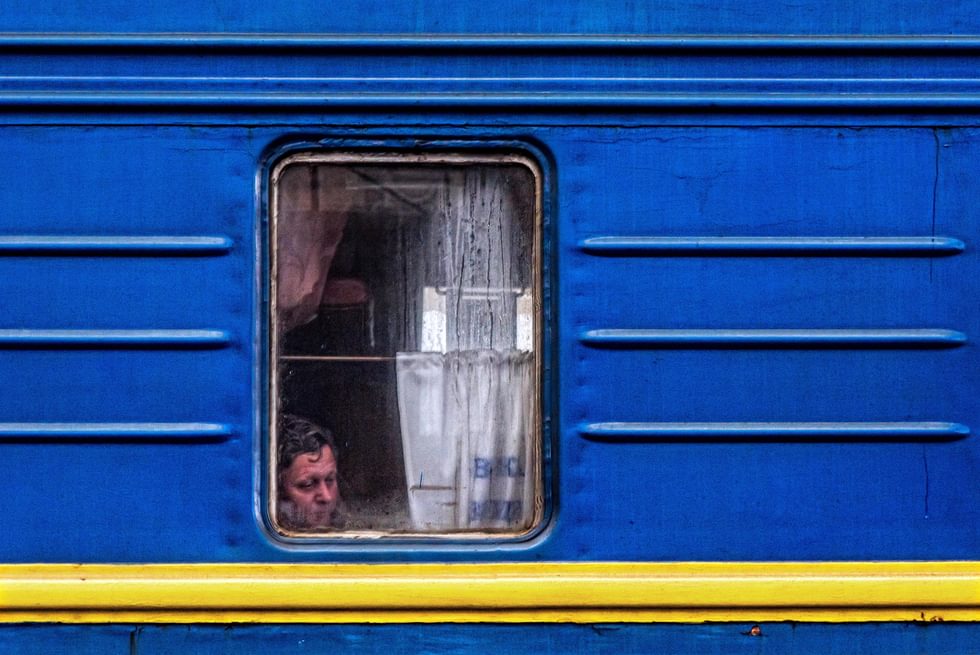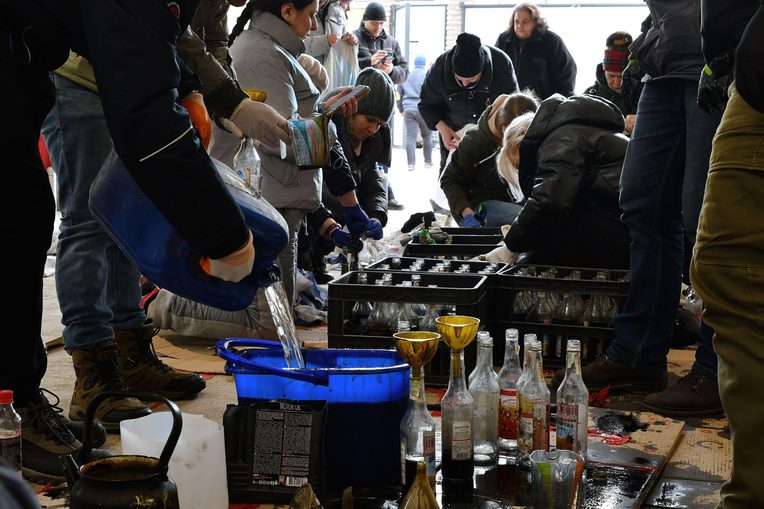Molotov Cocktails and Self-Organization in a Time of War
From the Series: Russia’s War on Ukraine
From the Series: Russia’s War on Ukraine

Закінчення війни - в руках кожного з нас! The end of the war is in each of our hands!
In the first week of Russia’s full-scale invasion into Ukraine, the General Staff of Ukraine’s Twitter account featured not only an image of the correct proportions of a Molotov cocktail, but also which parts of a Russian tank would be most vulnerable to such a projectile. The post (since removed from Twitter, but available through Wayback Machine) was tagged with the slogan, “The end of the war is in EACH OF OUR HANDS! Destroy! Burn! Throw the enemy out of your home and out of your country!”
Since then, videos have proliferated around social media, showing whole communities creating an assembly line of Molotov cocktails and Ukrainians throwing cocktails out of car windows as they pass Russian tanks. One billboard in the southern city of Odesa read, in a mix of Russian and Russian spelled in the Ukrainian alphabet, “Hot Tour: See Ukraine and Die! Cocktails included.” A popular Lviv-based brewery used an image of Molotov cocktails in their beer bottles to ask for donations and support from abroad.
The Molotov cocktail has long been a weapon of choice for underdogs. Used widely by the Finnish army in their fight against the Russian invasion of their own eastern territories in 1939 and 1940, the weapon has a special resonance in Ukraine. During the 2013–14 Euromaidan mobilizations—when Ukrainians ousted pro-Russian President Viktor Yanukovych—ordinary people joined the protests armed with Molotov cocktails, fireworks, and cobblestones torn from Kyiv’s streets to lob at riot police. These weapons became symbolic of the protests and their success, along with orange plastic construction helmets that served as tactical gear when protesters were cobbling together protective clothing.
As I argue in my forthcoming book, self-organization (Ukr. samo-orhanizatsiia) is the basic idea that if something needs to be done, and someone has the skill set to do it, then they should simply do it. The Euromaidan protests were grounded in self-organization, and they succeeded because people who had skills or resources shared those skills and resources when necessary, without relying on state institutions or political parties to do what needed to be done. I suggest that in Ukraine, people’s relationships with political participation were shaped by the experience of successful self-organization during these protests.
In 2014, self-organization was not just about throwing Molotov cocktails or putting on bulletproof vests to face off with the riot police—although this was an important component. Activists who did not want to participate in violence created a network called “The Hospital Guards” (Ukr. Varto u likarni), in which volunteers took turns waiting at hospitals to protect protesters from police who were trying to arrest them, kidnap them, or try to force confessions out of them while they were incapacitated. When the war in eastern Ukraine began later that year, self-organized volunteer groups gathered supplies to support the military and to provide services at the front lines. Ordinary citizens in the cities and towns flooded with internally displaced people from Donetsk and Luhansk mobilized to find them shelter and supplies; some of these self-organized initiatives became successful nongovernmental organizations. When I interviewed a woman who was at the heart of one such initiative, she told me that these self-organized mobilizations were rooted in Euromaidan and the spirit of knowing that ordinary people could make change. Self-organization is thus not only an important motivating framework for political participation but also a lens through which Ukrainians today analyze, assess, and value their actions.
Self-organization is once again taking center stage in the most recent Russian invasion of Ukraine. And, like in 2014, self-organization in 2022 is not just about creating weapons or picking up guns to defend Kyiv. People remember how they banded together to help one another and are doing so again across social media. They are organizing cars to help evacuate people to relative safety in the west. They are asking what people need in the cities under siege so they can deliver supplies. They are sharing information about which highways are passable. They are translating into English videos of captured Russian soldiers who had no idea they were being sent to kill Ukrainians. All of these initiatives are again being mobilized based on people’s existing skill sets and resources. Those who want to fight are fighting. Those who can better help from elsewhere are doing so again.
This time, the difference is that the Ukrainian government is standing with and for the people living in Ukraine. In 2014, people had to self-organize to fight Viktor Yanukovych and his pro-Russian government. Now, self-organization is going hand in hand with a government that is doing its best to represent Ukraine to the rest of the world. And the government is also helping ordinary citizens take power in their own hands by sharing information on how to construct the most effective Molotov cocktail.
Molotov cocktails are just one of the examples of how people are self-organizing to respond to the much more sophisticated Russian military threat in 2022. The spread of information about how to make and throw them via social media, as well as jokes about them—as seen on the Odesa billboard—evoke the spirit of the 2014 protests, when people faced violence and the risk of bodily harm with a sense of humor and resolve. Molotov cocktails are not just a weapon; they are a reminder of how Ukrainians already fought against a much greater, much better equipped foe—and won.
